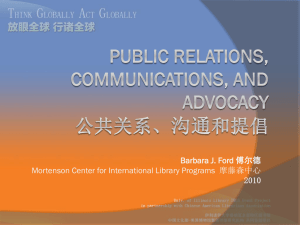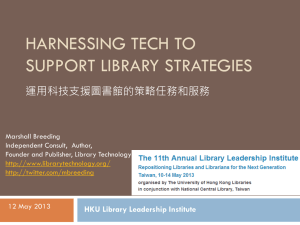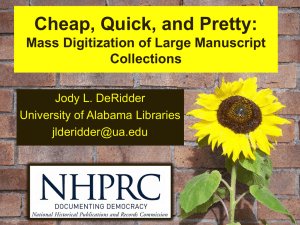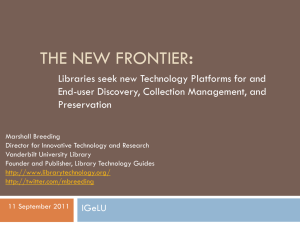New opportunities in times of change
advertisement
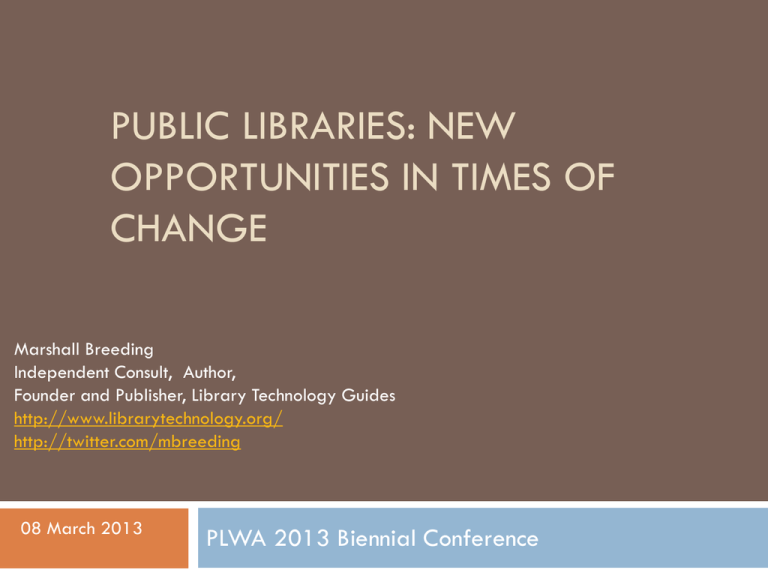
PUBLIC LIBRARIES: NEW OPPORTUNITIES IN TIMES OF CHANGE Marshall Breeding Independent Consult, Author, Founder and Publisher, Library Technology Guides http://www.librarytechnology.org/ http://twitter.com/mbreeding 08 March 2013 PLWA 2013 Biennial Conference Summary Public libraries face many challenges in the ways they serve their communities in these times of great change in society and technology. Interest in e-books has taken off, presenting enormous opportunities—if libraries can navigate through all the obstacles—to deliver lending services that delight their customers. Finding new ways to foster engagement with their communities stands as a paramount concern. Libraries have a growing set of options to bring in the character of social networks into their sphere. Most importantly, libraries can work to become a hub for their community, expanding beyond traditional methods of library service. Marshall Breeding will present his view of the role of libraries in this critical time of change and some of the ways that libraries can improve their standing in their communities in the way that they shape their services and in their use of technology. Library Technology Guides Public Libraries in Australia Public Libraries in Western Australia Library Journal Automation Marketplace Published annually in April 1 issue Based on data provided by each vendor Focused primarily on North America Context market of global library automation LJ Automation Marketplace Annual Industry report published in Library Journal: 2012: Agents of Change 2011: New Frontier: battle intensifies to win hearts, minds and tech dollars 2010: New Models, Core Systems 2009: Investing in the Future 2008: Opportunity out of turmoil 2007: An industry redefined 2006: Reshuffling the deck 2005: Gradual evolution 2004: Migration down, innovation up 2003: The competition heats up 2002: Capturing the migrating customer Cloud Computing for Libraries Book Image Publication Info: Volume 11 in The Tech Set Published by NealSchuman / ALA TechSource ISBN: 781555707859 http://www.neal-schuman.com/ccl Next-Gen Library Catalogs Marshall Breeding Neal-Schuman Publishers March 2010 Volume 1 of The Tech Set Appropriate Automation Infrastructure Current automation products out of step with current realities Centered on transactional support Proliferation of disconnected tech components Majority of automation efforts support print activities Management of e-content continues with inadequate supporting infrastructure Need better virtual presence that covers full breadth of library collection and services Library users expect more engaging socially aware interfaces for Web and mobile Allocation of resources Libraries need flexible technical infrastructure that responds to changing priorities Collection funds devoted mostly to e-content Allocation of technology infrastructure and personnel devoted mostly to management of print Not hardwired to specific content media, workflows, or services Technology to support all faces of public libraries Physical Social / Community Digital Reshaped collections Monographs: transition to e-books underway Demand for e-book discovery and lending For academics, E-books now largely delivered through database aggregations Digital collections: local libraries and cultural organizations actively involved in digitizing unique materials Journal content: mostly delivered electronically Media collections: LP, CD, DVD, Blu-Ray to streaming Heritage print collections will remain indefinitely Fulfillment activities Print circulation Increasing Increasing reliance on self-service Direct consortial borrowing Interlibrary loan activity rising Increased pressure for resource sharing Additional public library roles Beyond content fulfillment Centers of community engagement Technology access for the under-served Ready reference > in-depth research support Improve Literacy, promote reading, etc Facilitating use of technology Stimulate creativity: Maker spaces Public Library Issues Greater concern for e-books and general article databases Management: Need for consolidated approach that balances print, digital, and electronic workflows Emphasis on technologies that engage users with library programs and services Cumulative effect Library collections more complex than ever Library services move diverse Managing electronic and digital content harder than managing print Tech for Physical Libraries Content stations: Catalog stations, e-book kiosks, specialized resources Self-service (RFID) – increasingly duplicating LMS / Online catalog functionality Digital signage and exhibits Computing: Wi-Fi – PCs – printing Multi-media tables Device Lending – increasingly self-service Anything to spark collaboration and engagement Social Computing Web 2.0 as a separate activity often counter productive Important to have social orientation built directly into the software and services that comprise library infrastructure Avoid jettisoning patrons out of the library’s Web presence Find ways to effectively connect with users, connect users to each other, and especially to connect users to library content and services Key Context: Changed expectations in metadata management Moving away from individual record-by-record creation Life cycle of metadata Manage metadata in bulk when possible E-book collections Highly shared metadata Metadata follows the supply chain, improved and enhanced along the way as needed E-journal knowledge bases (KnowledgeWorks / 360 Core) Great interest in moving toward semantic web and open linked data Very little progress in linked data for operational systems AACR2 > RDA MARC > RDF (recent announcement of Library of Congress) Enterprise connectivity Important to be interconnected with the technical infrastructure of related organizations: Council services, Campus, UK: strong dynamic between local council business systems and that of the library service Fundamental technology shift Mainframe computing Client/Server Cloud Computing http://www.flickr.com/photos/carrick/61952845/ http://soacloudcomputing.blogspot.com/2008/10/cloud-computing.html http://www.javaworld.com/javaworld/jw-10-2001/jw-1019-jxta.html Mobile Computing Cooperation and Resource sharing Efforts on many fronts to cooperate and consolidate Many regional consortia merging (Example: suburban Chicago systems) State-wide or national implementations Software-as-a-service or “cloud” based implementations Many libraries share computing infrastructure and data resources Illinois Heartland Library Consortium Largest Consortium in US by Number of Members Strategic Cooperation Shared infrastructure in support of strategic collaborative relationships Opportunities to share infrastructure Examples: 2CUL Orbis Cascade Alliance Opportunities to reconsider automation implementation strategies One library = 1 ILS? Ability to share infrastructure across organizational boundaries? Shared Infrastructure Northern Ireland South Australia Denmark (tender process underway) Chile Iceland Challenge: Disjointed approach to information and service delivery Library Web sites offer a menu of unconnected silos: Books: Library OPAC (ILS online catalog module) Articles: Aggregated content products, e-journal collections OpenURL linking services E-journal finding aids (Often managed by link resolver) Subject guides (e.g. Springshare LibGuides) Local digital collections ETDs, photos, rich media collections Metasearch engines Discovery Services – often just another choice among many All searched separately Integrated service Delivery A unified interface that takes full responsibility for customer experience Avoids abrupt hand-offs Does not jettison customers away from the library presence Inward vectors of engagement Integrating e-Books into Library Automation Infrastructure Current approach involves mostly outsourced arrangements Collections licensed wholesale from single provider Hand-off to DRM and delivery systems of providers Loading of MARC records into local catalog with linking mechanisms No ability to see availability status of e-books from the library’s online catalog or discovery interface Online Catalog ILS Data Search: Scope of Search Search Results Books, Journals, and Media at the Title Level Not in scope: Articles Book Chapters Digital objects Web site content Etc. Public Library Information Portal LMS Data Digital Collections Search: Usagegenerated Data Customer Profile Consolidated Index Search Results Web Site Content Community Information Aggregated Content packages … Customerprovided content Reference Sources Archives Pre-built harvesting and indexing Discovery Products http://www.librarytechnology.org/discovery.pl Fragmented Library Management LMS for management of (mostly) print Duplicative financial systems between library and local government or other parent organization E-book lending platform (multiple?) Interlibrary loan (borrowing and lending) Self-service and AMH infrastructure Electronic Resource Management PC Scheduling and print management Event scheduling Digital Collections Management platforms (CONTENTdm, DigiTool, etc.) Discovery-layer services for broader access to library collections No effective integration services / interoperability among disconnected systems, non-aligned metadata schemes Library management systems Traditionally focus on circulation, cataloging, and acquisitions Neglect patron-facing services New generation needs to operate as: Customer relationship management Enterprise Resource Management Collection management Patron discovery and service fulfillment Automation priorities Current LMS model focuses on technical services Discovery interfaces and catalog address patron self-service General absence of customer relationship management How can new generations of technology infrastructure provide tools to facilitate research support, reference, and other public services Need to generate performance metrics for these critical library services Comprehensive Resource Management No longer sensible to use different software platforms for managing different types of library materials ILS + ERM + OpenURL Resolver + Digital Asset management, etc. very inefficient model Flexible platform capable of managing multiple type of library materials, multiple metadata formats, with appropriate workflows Open Systems Achieving openness has risen as the key driver behind library technology strategies Libraries need to do more with their data Ability to improve customer experience and operational efficiencies Demand for Interoperability Open source – full access to internal program of the application Open API’s – expose programmatic interfaces to data and functionality Libraries need a new model of library automation Not an Integrated Library System or Library Management System The ILS/LMS was designed to help libraries manage print collections Generally did not evolve to manage electronic collections Other library automation products evolved: Electronic Resource Management Systems – OpenURL Link Resolvers – Digital Library Management Systems -Institutional Repositories Library Services Platform Library-specific software. Designed to help libraries automate their internal operations, manage collections, fulfill requests, and deliver services Services Service oriented architecture Exposes Web services and other API’s Facilitates the services libraries offer to their users Platform General infrastructure for library automation Consistent with the concept of Platform as a Service Library programmers address the APIs of the platform to extend functionality, create connections with other systems, dynamically interact with data Library Services Platform Characteristics Highly Shared data models Knowledgebase architecture Some may take hybrid approach to accommodate local data stores Delivered through software as a service Multi-tenant Unified workflows across formats and media Flexible metadata management MARC – Dublin Core – VRA – MODS – ONIX New structures not yet invented Open APIs for extensibility and interoperability New Library Management Model Search: Unified Presentation Layer Library Services Platform API Layer ` Digital Coll Consolidated index Self-Check / Automated Return ProQuest EBSCO … JSTOR Stock Management Enterprise Resource Planning Learning Management Other Resources Smart Cad / Payment systems Authentication Service Reassess expectations of Technology Many previous assumptions no longer apply Technology platforms scale infinitely No technical limits on how libraries share technical infrastructure Cloud technologies enable new ways of sharing metadata Build flexible systems not hardwired to any given set of workflows Reassess workflow and organizational options ILS model shaped library organizations New Library Services Platforms may enable new ways to organize how resource management and service delivery are performed New technologies more able to support strategic priorities and initiatives Time to engage Transition to new technology models just underway More transformative development than in previous phases of library automation Opportunities to partner and collaborate Vendors want to create systems with long-term value Question previously held assumptions regarding the shape of technology infrastructure and services Provide leadership in defining expectations



